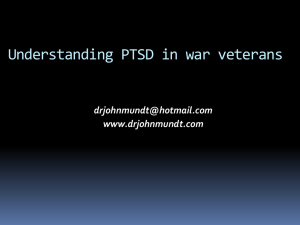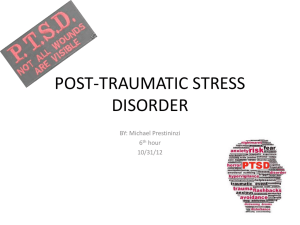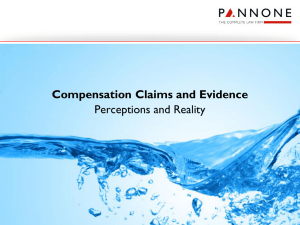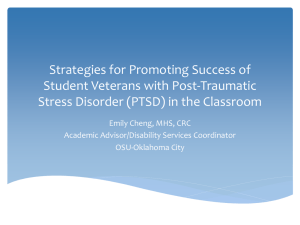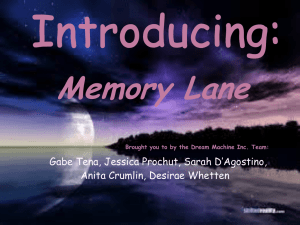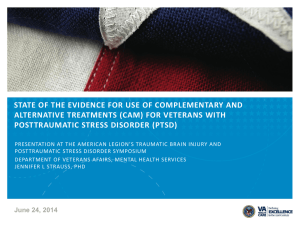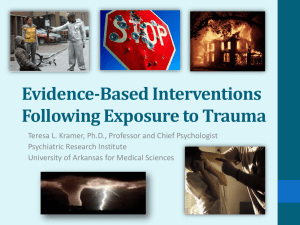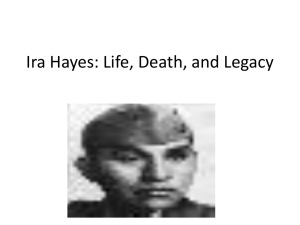Assessing and Treating Trauma in Clients with Concurrent Disorders
advertisement
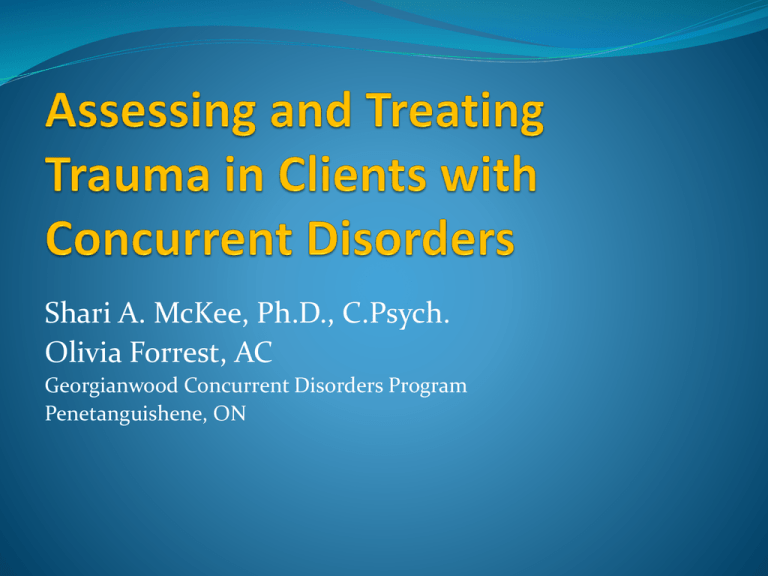
Shari A. McKee, Ph.D., C.Psych. Olivia Forrest, AC Georgianwood Concurrent Disorders Program Penetanguishene, ON Georgianwood Concurrent Disorders Program Located at the Waypoint Centre (formerly the Mental Health Centre Penetanguishene) Revamped in 2007 – became 3-month residential program offering fully integrated substance use and mental illness treatment for adults 12–bed program was based on best-practice recommendations for CDs Groups include CBT, Seeking Safety, skills training, self-help facilitation, psychoeducation, family education, anger management, leisure education, discharge planning & aftercare Prevalence of PTSD in CD Populations Rates of PTSD among clients in treatment for substance abuse range from 25-42% (E.g., Brady et al., 2004; Langeland & Hartgers, 1998) Studies that focused only on women find higher rates: 30-59% (E.g., Najavits et al., 1997; Stewart et al., 1999) Master’s thesis data collected at Georgianwood found that 60% of our clients met DSM-IV criteria for PTSD What Does the Research Say? Becoming abstinent from substances does not resolve PTSD; but successfully treating PTSD does lead to decreases in substance abuse (Brady et al., 1994; Hien et al, 2010) Treatment outcomes for clients with PTSD and substance abuse are worse than for other clients with concurrent disorders and for those solely with substance abuse (Ouimette et al., 2003) When PTSD symptoms worsen, substance misuse symptoms worsen and vice versa (Henslee & Coffey, 2010) What are the Recommendations? (Henslee & Coffey, 2010) Assess trauma symptoms in all clients. Provide trauma-focused treatment to addicted clients with PTSD. Manuals have been created which offer combined PTSD & substance abuse treatment (e.g., Seeking Safety; Concurrent Treatment of PTSD and Cocaine Dependence; Substance Dependence PTSD Treatment) Despite the difficulties in administration, prolonged exposure therapy is the gold standard in PTSD treatment. Screening for PTSD All clients should be routinely screened for PTSD. There are many screening/assessment tools available. National Center for PTSD lists many available free screeners and assessment tools on their website. We use the PTSD Checklist (PCL-S; Weathers, Litz, Huska, & Keane, 1994) & the Brief Trauma Questionnaire (Schnurr, Vielhauer, Weathers & Findler, 1999). PTSD Screeners First determine whether the client experienced at least 1 traumatic event meeting DSM-IV criteria: “(1) person experienced, witnessed, or was confronted with an event or events that involved actual or threatened death or serious injury, or a threat to the physical integrity of self or others; (2) the person's response involved intense fear, helplessness, or horror.” PTSD Screeners cont’d Then determine whether they have experienced PTSD symptoms for at least 1 month: 1. Reexperiencing (1)(e.g., dreams, flashbacks) 2. Avoidance & Numbing (3)(e.g., avoid thoughts, people, objects that are reminders of the trauma; diminished interest; detachment) 3. Increased arousal (2) (e.g., sleep problems, startle, hypervigilance, irritability) Suggestions for Effective Screening We do trauma screening within 2 days of admission. Assign the task to one person who should use a gentle, empathic approach. Give a rationale for the screening: we are asking this so any PTSD symptoms can be addressed. Ask briefly for past traumas but do not elicit so much detail that it is re-traumatizing for the client. Suggestions for Effective Screening cont’d Score the tool ASAP so can give feedback to the client. If they screen positive for PTSD, invite them to attend Seeking Safety and give information about the group. Instill hope – we can work with you to help you with these PTSD symptoms. Seeking Safety (2002) Developed by Lisa Najavits at Harvard. Is considered first stage treatment for concurrent PTSD & substance abuse (which involves safety). Safety from substance abuse, self-harm, violent relationships etc. Many clients will require further treatment. Fully-integrated curriculum – addresses substance use & PTSD in every session. Seeking Safety cont’d Teaches healthy coping skills in 25 sessions (hard to cover that many sessions) Groups are psychoeducational but manual offers ideas on how to make it more skills-focused. The group involves NO trauma details. Seeking Safety Training Five Georgianwood staff attended a 2-day Najavits workshop in Toronto. Had to decide on which sessions we would offer in our 12-week program. Currently have a weekly 2-hour group that is co-led by an addiction counselor and an RN – mixed gender group. Seeking Safety Topics Include: 1. *Grounding 2. 3. 4. 5. 6. 7. 8. 9. 10. 11. 12. *Asking for help Safety *Compassion *Setting boundaries Healing from anger *Self-nurturing Coping with triggers Recovery thinking Healthy relationships *Integrating the split self Community resources 13. *Honesty 14. *Taking good care of yourself 15. Getting others to support your 16. 17. 18. 19. 20. 21. 22. recovery *Taking back your power *Red & green flags Commitment Creating meaning When substances control you Discovery Respecting your time Core Concepts of Seeking Safety Stay safe Respect yourself Use coping – not substances- to escape the pain Make the present and future better than the past Learn to trust Take good care of your body Get help from safe people If one method doesn’t work, try something else Never, never, never, never, never give up! Seeking Safety Session Format • • • • • Check-in Quotation Handouts on the topic– discussion, practice skills Commitment (homework) Check-out / feedback Check-in (5 mins/client) 5 minutes per client max Ask clients to reflect on how they are feeling and how things have gone over the past week: 4 questions: How are you feeling? Did you practice any safe coping this week? Any substance use or other unsafe behaviour this week? Did you complete your commitment? Quotation (5 minutes) Helps to engage the clients emotionally in the session. E.g., for “Safety” session: “Although the world is full of suffering, it is full also of the overcoming of it.” – Helen Keller Ask “What is the main point of the quotation?” Handouts on the Topic & Discussion/Practice (50 minutes) Handouts copied from manual 2-5 handouts per topic May take up to 4 sessions to get through all handouts on a topic Clients encouraged to read handouts out loud Each main point is discussed by group & topic is related to each client’s life Many topics have suggestions for behavioural skills practice (i.e., role plays) Example: “Grounding” Topic Gives definition of grounding: a distraction technique used to detach from emotional pain. Explains rationale for grounding: to gain control over your feelings and stay safe (from substance use or self-harm). Guidelines for grounding: Can use it anywhere, any time Use it to deal with cravings, anger, dissociation, pain Keep eyes open Focus on the present 3 Types of Grounding – clients practice each type of grounding as a group 1. Mental Grounding: describe your environment; categories game (cities that start w/ A, B, etc); read 2. Physical Grounding: cool water on hands; grip chair; dig heels into floor; touch grounding object 3. Soothing Grounding: say kind statements; think of favourites (foods, TV shows); photos of loved ones Commitment (1min/client) Similar to homework in CBT. Is optional but encouraged. Clients can choose a commitment idea from a list or make up one of their own. Idea is to put into practice some of the safe coping skills. Example of Commitments Safe coping sheet – contrast old ways of coping versus new, safe ways. Find a small grounding object, such as a stone, to carry with them. Writing a letter or a story (e.g., a letter giving themselves permission to nurture themselves). Practice grounding for 10 minutes. Practice self-nurturing (e.g., take a long bath) Check-out (10 mins) To reinforce the clients’ progress and give therapist feedback. How was the session today? What did you like? What didn’t you like? What is your new commitment? Outcome Research: Seeking Safety Seeking Safety is the only model of concurrent PTSD and substance abuse that meets Chambless & Hollon (1998) criteria as an “effective treatment”. The evidence comes from 6 pilot studies, 4 RCTs, 1 controlled nonrandomized trial, 2 multisite controlled trials and 1 dissemination study. All outcomes studies showed positive outcomes – all studies showed reduction in PTSD symptoms and all but 1 found reductions in substance use (that study did not use all Seeking Safety sessions). Outcome Research: Seeking Safety cont’d In 4 out of 5 controlled trials, Seeking Safety outperformed the comparison condition (treatment as usual). Seeking Safety was also found to have several advantages over other treatments: greater therapeutic alliance more rapid PTSD improvement greater HIV risk reduction greater sustaining of gains during follow-up greater impact on clients who were heavy substance users. Outcome Research: Seeking Safety cont’d Treatment satisfaction was high in all studies. More research is needed: What are the key components to treatment effectiveness? How many sessions are needed for optimal response? Does clinician training impact outcomes? How does Seeking Safety do compared to other manualized treatments? Fidelity & Knowledge Acquisition It is recommended that regular fidelity checks are done to assess whether the therapists are sticking to the manual. All of our sessions are audiotaped and the psychologist listens to random tapes and assesses fidelity to the Seeking Safety model (Seeking Safety Adherence Scale). Also created a pre/post quiz to measure knowledge acquisition of key Seeking Safety skills and concepts. Screen for PTSD pre and post program – have their symptoms decreased as a result of the program? Preliminary Data: Georgianwood N = 57 all screening positive for PTSD on admission. On discharge, 41 (72%) no longer screened positive for PTSD. Improvements likely due to a combination of factors: 3 months of sobriety, a supportive environment, CBT and Seeking Safety. Example: “Compassion” Quotation: “You yourself, as much as anybody in the entire universe, deserve your love and affection.” Buddha Exposure Therapy Exposure therapy is an evidence-based intervention & is considered the “gold-standard” of trauma treatment. Exposure therapy was the only psychosocial treatment deemed effective for PTSD by the Institute of Medicine (2008). Edna Foa - named one of Time Magazine’s 100 Most Influential People in the World in 2010, to acknowledge how effective exposure therapy has been in treating PTSD. Exposure Therapy cont’d Involves clients being exposed to memories or to objects/situations that remind them of a trauma. It is thought to work by allowing the client to see that although the traumatic event wasn’t safe, the memories and reminders of the event are safe. It also involves clients repeatedly exposing themselves to the feared objects/memories, allowing for habituation of the fear. It also allows the client to fully process what happened to them (which avoidance does not permit). Prolonged Exposure Typically involves 2 types of exposure work: 1. In Vivo – client is exposed to objects (e.g., dogs) or situations (e.g., going to a grocery store) that are associated with a trauma and that cause fear and avoidance. 2. Imaginal – client is exposed to memories of the traumatic event. Prolonged Exposure cont’d Work with the client to create 2 hierarchies – one for in vivo and one for imaginal. Want a range of objects/memories – from mild anxiety to severe anxiety. Slowly work up the hierarchy – as they experience success with the less anxiety-provoking items, they develop confidence to tackle the more difficult items. Prolonged Exposure: Warnings Not easy – is difficult for the client and the therapist. Need extensive background in CBT first. Need to fully understand the rationale for PE. Need to follow closely to an effective manual. Should get supervision/ consultation when first doing this work. For CSA and BPD, the combination of PE with DBT is recommended. In the short-run can increase nightmares/flashbacks – and should continuously assess for suicidal ideation. Summary The majority of CD clients have experienced significant trauma and many have PTSD. Treating their substance abuse without addressing the trauma leads to poorer outcomes. Screen all concurrent disorders clients for PTSD. When identified, either refer or treat in-house. There are a number of CD/PTSD manualized treatments available (e.g., Seeking Safety). Summary cont’d Identify staff who may have the interest and background to get training and supervision in exposure therapy. Considering training in DBT to increase the effectiveness of your trauma interventions. Reassess PTSD symptoms after treatment to see whether it was effective. Very good substance use outcomes can be achieved when trauma is treated concurrently! Thank you! smckee@waypointcentre.ca oforrest@waypointcentre.ca References Brady, K.T., Killeen, T., Saladin, M.E., Dansky, B, & Becker, S. (1994). Comorbid substance abuse and posttraumtic stress disorder: Characteristics of women in treatment. American Journal of Addictions, 3, 160-164. Brady, K.T., Back, S.E., & Coffey, S.F. (2004). Substance abuse and posttraumatic stress disorder. Current Directions in Psychological Science, 13, 206-209. Chambless, D.L. & Hollon, S.D. (1998). Defining empirically supported therapies. Journal of Consulting and Clinical Psychology, 66, 7-18. Cohen LR, Hien DA.(2006). Treatment outcomes for women with substance abuse and PTSD who have experienced complex trauma. Psychiatric Services, 57(1):100-106. Cook, J.M., Walser, R.D., Kane, V., Ruzek, J. I., Woody, G.(2006). Dissemination and feasibility of a cognitive-behavioral treatment for substance use disorders and posttraumatic stress disorder in the Veterans Administration. Journal of Psychoactive Drugs, 38, 89-92. Desai RA et al. (2008). Treatment for homeless female veterans with psychiatric and substance abuse disorders: Impact of "Seeking Safety" on one-year clinical outcomes. Psychiatric Services, 59, 996-1003. Desai, RA et al. (2009). Seeking Safety therapy: Clarification of results. Psychiatric Services, 60, 125. Gatz M, Brown V, Hennigan K, Rechberger E, O'Keefe M, Rose T, Bjelejac P, 2007), Effectiveness of an integrated trauma-informed approach to treating women with co-occurring disorders and histories of trauma. J. Community Psychology, 35, 863-878. Henslee, A.M. & Coffey, S.F. (2010). Exposure therapy for posttraumatic stress disorder in a residential substance use treatment facility. Professional Psychology: Research and Practice, 41, 34-40. Hien DA, Cohen LR, Litt LC, Miele GM, Capstick, C. (2004). Promising empirically supported treatments for women with comorbid PTSD and substance use disorders. American Journal of Psychiatry, 161:1426-1432. Hien DA, Wells EA, Jiang H, Suarez-Morales L, Campbell AN, Cohen LR, et al. (2009). Multisite randomized trial of behavioral interventions for women with co-occurring PTSD and substance use disorders. Journal of Consulting and Clinical Psychology, 77(4):607-19. Hien,D.A., Jiang, H., Campbell, A.N., Hu, M., Miele, G.M., et al, (2010). Do treatment improvements in PTSD severity affect substance use outcomes? A secondary analysis from a randomized clinical trial in NIDA’s Clinical Trials Network. American Journal of Psychiatry, 167, 95-101. Holdcraft, L.C. & Comtois, K.A. (2002). Description of and preliminary data from a women�s dual diagnosis community mental health program. Canadian Journal of Community Mental Health: 21:91-109. Langeland, W. & Hartgers, C. (1998). Child sexual and physical abuse and alcoholism: A review. Journal of Studies on Alcohol, 336-348. Morrissey, JP, Jackson, EW, Ellis, AR, Amaro, H, Brown, VB, Najavits, LM. (2005). Twelve-month outcomes of trauma-informed interventions for women with co-occurring disorders. Psychiatric Services, 56, 1213-1222. Najavits, L. (2002). Seeking Safety: A treatment manual for PTSD and substance abuse. New York: The Guilford Press. Najavits LM, Gallop RJ, Weiss RD. (2006). Seeking Safety therapy for adolescent girls with PTSD and substance abuse: A randomized controlled trial. Journal of Behavioral Health Services & Research, 33, 453-463. Najavits, LM, M. Schmitz, S. Gotthardt, S., Weiss, R.D. (2005). Seeking Safety plus Exposure Therapy for Dual Diagnosis Men. Journal of Psychoactive Drugs, 27, 425-435. Najavits, L., Weiss, R.D., & Shaw. S.R. (1997). The link between substance abuse and posttraumatic stress disorder in women: A research review. American Journal on Addictions, 6, 273-283. Najavits LM, Weiss RD, Shaw SR, Muenz L. (1998). "Seeking Safety": Outcome of a new cognitive-behavioral psychotherapy for women with posttraumatic stress disorder and substance dependence. Journal of Traumatic Stress, 11:437 456. Norman SB, Wilkins KC, Tapert SF, Lang AJ, Najavits LM. A pilot study of seeking safety therapy with OEF/OIF veterans. Journal of Psychoactive Drugs 2010;42:83-87. Ouimette, P.C., Moos,R.H., & Finney, J.W. (2003). PTSD treatment and 5-year remission among patients with substance use and posttraumatic stress disorders. Journal of Consulting and Clinical Psychology, 71, 410-414. Schnurr,P. Vielhauer, M., Weathers,F., & Findler, M. (1999). Brief Trauma Questionnaire. White River Junction, VT: National Center for PTSD. Stewart, S.H., Conrod, P.J., Pihl, R.O., & Dongier, M. (1999). Relations between posttraumatic stress symptom dimensions and substance dependence in a community-recruited sample of substance-abusing women. Psychology of Addictive Behaviors, 13, 78-88. Weathers,F., Litz, B., Huska, J., & Keane, T. (1994). PTSD Checklist (PCL-S). National Center for PTSD - Behavioral Science Division. Weller LA (2005). Group therapy to treat substance use and traumatic symptoms in female veterans. Federal Practitioner, 27-38. Zlotnick C, Johnson J, Najavits LM. (2009). Randomized controlled pilot study of cognitive-behavioral therapy in a sample of incarcerated women with substance use disorder and PTSD. Behavior Therapy, 40(4):325-36. Zlotnick C, Najavits LM, Rohsenow DJ. (2003) A cognitive-behavioral treatment for incarcerated women with substance use disorder and posttraumatic stress disorder: Findings from a pilot study. Journal of Substance Abuse Treatment, 25:99-105.
